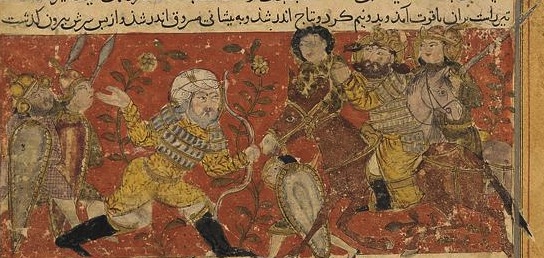Tarikhnama on:
[Wikipedia]
[Google]
[Amazon]
 ''Tarikh-i Bal'ami'' ( fa, تاریخ بلعمی, , History of Bal-ami) or ''Tārīkhnāmeh'' (, 'Book of History') is the earliest known extant prose book in the
''Tarikh-i Bal'ami'' ( fa, تاریخ بلعمی, , History of Bal-ami) or ''Tārīkhnāmeh'' (, 'Book of History') is the earliest known extant prose book in the
 ''Tarikh-i Bal'ami'' ( fa, تاریخ بلعمی, , History of Bal-ami) or ''Tārīkhnāmeh'' (, 'Book of History') is the earliest known extant prose book in the
''Tarikh-i Bal'ami'' ( fa, تاریخ بلعمی, , History of Bal-ami) or ''Tārīkhnāmeh'' (, 'Book of History') is the earliest known extant prose book in the Persian language
Persian (), also known by its endonym Farsi (, ', ), is a Western Iranian language belonging to the Iranian branch of the Indo-Iranian subdivision of the Indo-European languages. Persian is a pluricentric language predominantly spoken a ...
written by Muhammad Bal'ami
Abu Ali Muhammad Bal'ami ( fa, ابو علی محمد, d. 992-997 CE), also called Amirak Bal'ami () and Bal'ami-i Kuchak (, "Bal'ami the Younger"), was a 10th-century Persian historian, writer, and vizier to the Samanids. He was from the influ ...
, a vizier
A vizier (; ar, وزير, wazīr; fa, وزیر, vazīr), or wazir, is a high-ranking political advisor or minister in the near east. The Abbasid caliphs gave the title ''wazir'' to a minister formerly called '' katib'' (secretary), who was ...
in Samanid service. The 10th-century text is a universal history
A universal history is a work aiming at the presentation of a history of all of mankind as a whole, coherent unit. A universal chronicle or world chronicle typically traces history from the beginning of written information about the past up to t ...
, spanning a period beginning with the dawn of creation through to the Islamic age. Having been translated into Turkish and Arabic
Arabic (, ' ; , ' or ) is a Semitic language spoken primarily across the Arab world.Semitic languages: an international handbook / edited by Stefan Weninger; in collaboration with Geoffrey Khan, Michael P. Streck, Janet C. E.Watson; Walter ...
, the book remained in circulation for a thousand years, and it is among the most influential books of Islamic historical literature. While the author claims the book is a Persian translation of al-Tabari's '' History of the Prophets and Kings'', it is actually an independent work.
The literary style deviates from that of earlier Pahlavi and Middle Persian
Middle Persian or Pahlavi, also known by its endonym Pārsīk or Pārsīg () in its later form, is a Western Middle Iranian language which became the literary language of the Sasanian Empire. For some time after the Sasanian collapse, Middle ...
works composed in the Sasanian Empire. The ''Tarikhnama'' is considered the starting point of an influential Persian historiographical tradition that makes use of Arabic loanwords, and is based more on Arabic (and Islamic) models than earlier Sasanian ones.
Bal'ami started translating the book on 352 AH (963 CE).
Various manuscripts of this book are today available in the libraries of Iran, India, Turkey and Europe, but none of them are complete and error-free. The oldest surviving manuscript seems to be from 7th century AH.
The book was translated into Persian language at the order of Mansur ibn Nuh
Abu Salih Mansur ( fa, ابو صالح منصور, Abu Ṣāliḥ Manṣur; died 13 June 976), better known as Mansur I () was amir of the Samanids from 961 to 976. The son of Nuh I (), his reign was characterized by weak rule and perpetual finan ...
, the Samanid amir
Emir (; ar, أمير ' ), sometimes transliterated amir, amier, or ameer, is a word of Arabic origin that can refer to a male monarch, aristocrat, holder of high-ranking military or political office, or other person possessing actual or cer ...
. The book provides invaluable information about the Sasanian Persia
The Sasanian () or Sassanid Empire, officially known as the Empire of Iranians (, ) and also referred to by historians as the Neo-Persian Empire, was the last Iranian empire before the early Muslim conquests of the 7th-8th centuries AD. Named ...
and mythical history of Iran. Generally considered merely an abridged version of Tabari's work, A. C. S. Peacock demonstrated that Balami reshaped Tabari's work considerably, and that the differences between the two works are such that the ''Tārīkhnāma'' is essentially a new work.
See also
*Shahnameh
The ''Shahnameh'' or ''Shahnama'' ( fa, شاهنامه, Šāhnāme, lit=The Book of Kings, ) is a long epic poem written by the Persian poet Ferdowsi between c. 977 and 1010 CE and is the national epic of Greater Iran. Consisting of some 50 ...
References
Sources
* {{cite book , last = Peacock , first = A. C. S. , authorlink = A. C. S. Peacock , title = Mediaeval Islamic Historiography and Political Legitimacy: Balʿamī's Tārīkhnāma , location = London and New York , publisher = Routledge , year = 2007 , isbn = 0-415-40025-2 Samanid Empire Iranian books 10th-century history books 963 Persian-language books